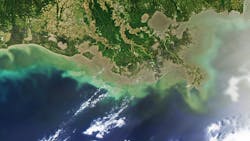Tribal Nations Receive $6M to Reduce Nutrient Pollution
The U.S. Environmental Protection Agency (EPA) announced the availability of $6 million in funds from the Bipartisan Infrastructure Law (BIL) to support Tribal Nations across the Mississippi/Atchafalaya River Basin (MARB) in reducing nutrient pollution on Tribal lands in the Basin.
BIL funding includes $60 million for actions to support water quality improvements in the Mississippi River watershed and Gulf of Mexico through the Gulf Hypoxia Program (GHP) over five years. EPA is allocating 10% of this funding – a total of $6 million – to 21 eligible Tribes to support capacity building activities and nutrient reduction demonstration projects that advance the goals of the Gulf Hypoxia Action Plan.
“The Biden-Harris Administration is committed to working alongside Tribes to advance our shared goal of improved water quality,” said Assistant Administrator for Water Radhika Fox. “Thanks to the historic Bipartisan Infrastructure Law, Tribes across this critical watershed will have resources to restore the Mississippi River and Gulf of Mexico.”
The announcement includes an implementation memorandum that provides eligible Tribes with information on how EPA will award and administer GHP funds, highlights priorities for nutrient reduction, and provides flexibility for Tribe-specific activities. With these awards, Tribes will support nutrient reduction demonstration projects, implement non-point source management programs, and build capacity to conduct nutrient reduction activities.
EPA has long supported the Hypoxia Task Force (HTF), with general support for Tribal and state water quality programs and targeted grants to states. The Bipartisan Infrastructure Law provides for dedicated funding to support Tribal nations, make progress towards reducing nutrient loads, and improve water quality in the Mississippi/Atchafalaya River Basin. Improving water quality in the watershed is critical for helping support families, economies, and communities that rely on this critical waterbody.
The Mississippi River/Gulf of Mexico Watershed Nutrient Task Force is a long-standing group of states, federal agencies, and a representative for Tribal nations that work collaboratively to reduce the large oxygen-depleted “dead zone” in the Gulf of Mexico and improve water quality throughout the Mississippi/Atchafalaya River Basin.
Under the Bipartisan Infrastructure Law, EPA is providing $50 billion to support state and Tribal investments in clean and safe water, and empower historically underserved and underrepresented communities with tools to improve their environmental conditions, including this allotment to Tribal nations under the Gulf Hypoxia Program.
